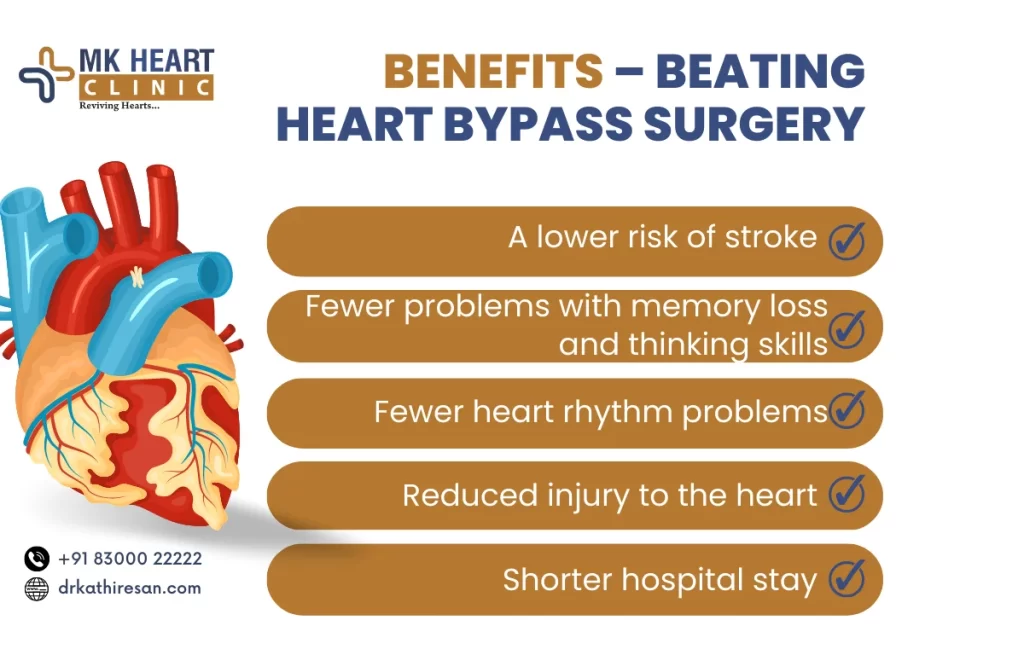In recent times, maintaining optimal functioning of all bodily systems, including the pulmonary and coronary systems, is crucial for overall health. If any of these systems are not functioning properly, surgical revascularization may be necessary. When these systems are working correctly, they ensure the proper flow of oxygen and blood to different parts of the body, which is essential for maintaining a healthy heart.
However, in recent times, this priority of keeping the heart healthy has been overshadowed by other factors. On the other hand, poor dietary habits and other lifestyle factors can contribute to poor heart health, resulting in a range of cardiovascular issues affecting individuals of all ages. If you experience any such issues, it is crucial to seek prompt medical attention from a qualified cardiologist in Chennai.
What is Surgical Revascularization?
Surgical revascularization is a medical procedure used to improve blood flow in the coronary arteries. It is also termed as coronary artery bypass grafting (CABG). This surgery involves using healthy blood vessels from other parts of the body, such as the chest or leg, to create new pathways for blood flow to the heart, bypassing blocked or narrowed arteries.
The new vessels are sewn in place above and below the blocked or narrowed area, allowing blood to flow around the blockage and reach the heart muscle.
This revascularization is often performed by the heart specialist in Chennai in cases of severe coronary artery disease or when other treatments, such as medication or lifestyle changes, have not been effective in restoring adequate blood flow to the heart.

When is Surgical Revascularization Performed?
Surgical revascularization is performed when blood flow to the heart or other parts of the body is significantly impaired due to blockages or narrowing of the blood vessels. It is typically considered as a treatment option when other medical treatments, such as medication or lifestyle changes, have failed to improve the condition. Specific indications for the procedure may include:
Coronary Artery Disease: In this condition, the arteries that supply blood to the heart become narrowed or blocked due to the buildup of plaque. This may lead to pain in the chest, shortness of breath, and even heart attack.
Peripheral Artery Disease: This condition requires surgical revascularization because it involves the buildup of plaque in the arteries that supply blood to the legs and feet, leading to pain, numbness, and poor wound healing.
Carotid Artery Disease: This condition involves the buildup of plaque in the arteries that supply blood to the brain, leading to an increased risk of stroke.
Aortic Disease: This condition involves the weakening or enlargement of the aorta, the largest artery in the body, which can lead to aortic aneurysm or dissection.
Renal Artery Stenosis: This condition involves the narrowing of the arteries that supply blood to the kidneys, leading to high blood pressure and kidney damage.
Ultimately, the decision to perform surgical revascularization will depend on various factors, including the patient’s overall health, the severity of their condition, and the expected benefits and risks of the procedure.
What are the Different Types of Surgical Revascularization Procedures?
There are several different types of surgical revascularization procedures, each of which is designed to address specific types of blockages or narrowing in the blood vessels. Some common types handled by the cardiologist in Chennai include:
Coronary Artery Bypass Grafting (CABG): This procedure involves creating a new pathway for blood flow around a blocked or narrowed section of a coronary artery. This is typically done using a healthy blood vessel taken from another part of the body, such as the leg or chest wall.
Carotid Endarterectomy: This procedure involves removing the buildup of plaque and other debris from the carotid arteries in the neck, which supply blood to the brain. This can help prevent stroke or other complications.
Peripheral Artery Bypass Grafting: This procedure of surgical revascularization performed by the heart specialist in Chennai involves creating a new pathway for blood flow around a blocked or narrowed section of a peripheral artery, such as those in the legs or arms. This is typically done using a healthy blood vessel taken from another part of the body, or using a synthetic graft.
Angioplasty and Stenting: This procedure involves using a balloon catheter to widen a narrowed or blocked section of a blood vessel, followed by the insertion of a small mesh tube which is called a stent for keeping the vessel open.
Endovascular Aneurysm Repair (EVAR): This procedure involves using a stent graft to reinforce a weakened or enlarged section of a blood vessel, such as an abdominal aortic aneurysm.
What Happens During this Procedure?
Surgical revascularization, also known as coronary artery bypass grafting (CABG), is a surgical procedure used to treat coronary artery disease (CAD). CAD occurs when the blood vessels that supply the heart muscle become narrow or blocked due to the build-up of plaque.
This reduces blood flow to the heart, causing chest pain (angina) and potentially leading to a heart attack. CABG is one of several treatment options for CAD and is generally considered when other treatments, such as medication or lifestyle changes, have not been effective.
Before the Procedure
Before the surgery, the patient will undergo a series of tests to assess their overall health and to determine the extent and location of the blockages in their coronary arteries. This may include a physical examination, blood tests, an electrocardiogram (ECG), a chest x-ray, and possibly a coronary angiogram, which involves injecting a dye into the arteries to make them visible on an X-ray.
The patient will also be given instructions on how to prepare for the surgery, which may include changes to their diet, medications, and lifestyle.
During the Procedure
The patient is put under general anesthesia before the procedure begins. The surgeon makes an incision in the chest, either in the center or to the side, to access the heart. The surgeon then takes a blood vessel, called a graft, from another part of the body. This may be an artery or a vein, and it is typically taken from the leg, chest, or arm.
The graft is then attached to the blocked or narrowed artery, bypassing the blocked area and restoring blood flow to the heart muscle. The surgeon may use one or more grafts depending on the number and location of the blockages. The graft is secured using small sutures, and the incision is closed using staples or sutures.
The entire procedure generally takes between 3 and 6 hours to complete, depending on the number and location of the blockages and the complexity of the surgery.
After the Procedure
After the surgery, the patient is transferred to the intensive care unit (ICU) for monitoring. They will typically remain in the hospital for several days, during which time they will be monitored for any complications and will receive medication to manage pain and prevent blood clots.
Once the patient is stable, they will be moved to a regular hospital room and will begin a program of physical therapy and rehabilitation to help them regain their strength and mobility. The length of hospital stays and recovery time after surgical revascularization varies depending on the patient’s overall health and the complexity of the surgery.
Indications for Surgical Revascularization: A Critical Decision
Surgical revascularization, often recommended for coronary artery disease, becomes necessary under specific conditions:
- Severe Coronary Artery Disease: When multiple arteries are significantly blocked, limiting blood flow to the heart muscle.
- Failure of Medical Management: When conservative treatments, such as medications or lifestyle changes, prove insufficient in relieving symptoms.
- High-Risk Anatomy: In cases where the anatomy or location of blockages is not suitable for less invasive interventions like angioplasty.
- Left Main Coronary Artery Disease: Particularly crucial when the left main coronary artery, a major vessel supplying the heart, is affected.
Surgical revascularization, commonly performed as coronary artery bypass grafting (CABG), aims to restore blood flow, alleviate symptoms, and improve overall heart function. The decision for surgical intervention is made based on a thorough assessment of the patient’s condition, considering factors like the extent and location of blockages, overall health, and the presence of comorbidities. It is a critical step in managing advanced coronary artery disease, emphasizing the importance of a personalized approach to cardiac care.
Benefits and Risks of Surgical Revascularization
The procedure of surgical revascularization performed by the heart specialist in Chennai has its own benefits and benefits. They include:
Benefits
- Improved Blood Flow: The main benefit of this procedure is that they can restore proper blood flow to the affected areas of the body.
- Symptom Relief: By restoring blood flow, these procedures can alleviate symptoms such as pain, numbness, and tingling in the affected area.
- Reduced Risk of Amputation: For patients with severe peripheral artery disease, surgical revascularization procedures can reduce the risk of amputation.
- Improved Quality of Life: By relieving symptoms and restoring blood flow, these procedures can improve patients’ overall quality of life and ability to perform daily activities.
Risks
- Bleeding: Surgery carries the risk of bleeding, both during and after the procedure.
- Infection: As with any surgical revascularization, there is a risk of infection.
- Blood Clots: Revascularization procedures can increase the risk of blood clots, which can lead to stroke or heart attack.
- Anesthesia Complications: The heart specialist in Chennai may use anesthesia during the procedure that can sometimes carry its own risks.
- Nerve Damage: The procedure can damage nerves, leading to loss of sensation or movement in the affected area.
- Failure of the Procedure: In some cases, the procedure may not be successful in restoring proper blood flow or relieving symptoms.
You have to consult with a cardiologist in Chennai if you experience any of the above-mentioned complications after the surgical revascularization.
Surgical Revascularization for Elderly Patients: Is It Safe and Effective?
Surgical revascularization, a procedure aimed at restoring blood flow to the heart, is commonly used to treat coronary artery disease (CAD). However, concerns arise when considering this approach for elderly patients due to their age-related health conditions and potential risks associated with surgery.
Several studies have shed light on this topic that surgical revascularization can be a viable and beneficial treatment option for elderly patients with CAD. One study found that elderly patients who underwent surgical revascularization had improved survival rates compared to those treated with medical therapy alone. Additionally, revascularization procedures, such as coronary artery bypass grafting (CABG), were associated with better long-term outcomes in terms of reducing angina symptoms and improving overall quality of life.
However, it is important to consider individual patient factors and carefully assess the risks and benefits. Elderly patients often have comorbidities, such as diabetes, hypertension, and kidney disease, which can increase the complexity of the procedure and potentially impact outcomes. Additionally, age-related physiological changes may affect the response to surgery and the recovery process.
To ensure the safety and effectiveness of surgical revascularization in elderly patients, a comprehensive preoperative evaluation is crucial. This evaluation should include a thorough assessment of the patient’s medical history, physical condition, and functional status. It is important to involve a multidisciplinary team consisting of cardiologists, surgeons, anesthesiologists, and geriatric specialists to optimize patient care and minimize potential risks.
Recovery Period
The recovery period after surgical revascularization varies depending on the type of procedure performed, the patient’s overall health, and the individual’s response to surgery. Most of these procedures require a hospital stay, ranging from a few days to several weeks.
Patients may need to take medications to manage pain and prevent blood clots during the recovery period. Besides that, lifestyle changes are also important for maintaining good health.
Conclusion
If you or dear ones have some cardiac or PAD disease, you can always consult Dr. M. Kathiresan the best cardiologist in Chennai at the MK Heart Clinic for getting the best surgical revascularization at an affordable treatment cost.



